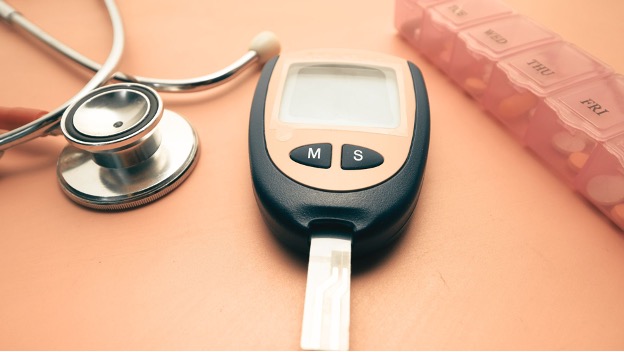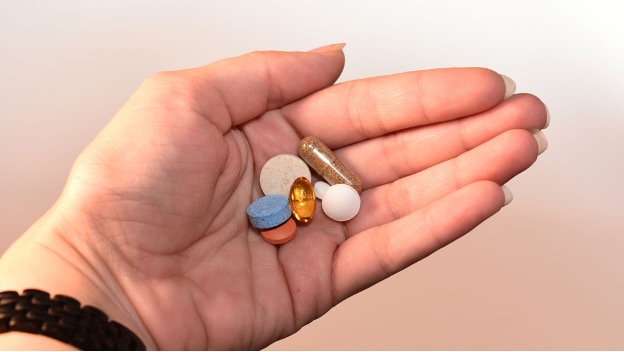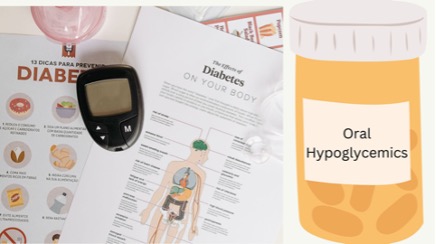Course
Oral Hypoglycemic Medications
Course Highlights
- In this Oral Hypoglycemic Medications course, we will learn about the risk factors and pathophysiology of Type 2 Diabetes Mellitus (DM).
- You’ll also learn the pros and cons of each oral hypoglycemic agent class.
- You’ll leave this course with a broader understanding of which oral hypoglycemic agents are considered first-line therapy, and create oral hypoglycemic treatment recommendations when first-line therapy is unsuccessful.
About
Pharmacology Contact Hours Awarded:
Course By:
Kimberlee Emfield Rowett
DNP (c), MSN, MBA, R.N.
Begin Now
Read Course | Complete Survey | Claim Credit
➀ Read and Learn
The following course content
Introduction
Oral hypoglycemic agents assist in lowering blood glucose levels. Oral hypoglycemic agents are primarily used in the management of type 2 diabetes mellitus but often have other indications for use, including Polycystic Ovary Syndrome (PCOS) with irregular menstruation, prevention of ovarian hyperstimulation syndrome undergoing intracytoplasmic sperm injection (ICSI) with in vitro fertilization (IVF), or to reduce weight-gain while on antipsychotic medication (10).
Type 2 Diabetes Mellitus
Type 2 Diabetes Mellitus (T2DM) is a metabolic disorder caused by two primary factors: defective insulin secretion by pancreatic β-cells, or the inability of insulin-sensitive tissues to respond appropriately to insulin (9).
Beyond the imbalance of blood glucose, T2DM also can lead to a metabolic imbalance that can lead to the development of secondary diseases. T2DM can lead to damage to the heart, vasculature, eyes, kidneys, and nerves (9). Characteristics of T2DM patients often include obesity or higher body fat percentage, which is more commonly located in the abdomen. This adipose tissue promotes insulin resistance due to various inflammatory mechanisms (9).
Other underlying causes for an increase in T2DM diagnoses include sedentary lifestyles, high-caloric diets, and aging patient populations (9).
Risk Factors
T2DM risk factors include genetic, metabolic, and environmental factors:
Genetic predisposition is seen in certain ethnicities, with the highest risk in Japanese, Hispanic, and Native American patients. Similarly, some studies indicated that genome variants impact intermediate mechanisms of T2DM pathophysiology, where four variants impact insulin resistance, two variants impact a reduction of insulin secretion in the fasting state, nine variants impact the lowering of insulin in a non-fasting state, and one variant impacts insulin processing (9)
Environmental factors include lifestyle choices. Obesity, low physical activity, and unhealthy diet all pose risks for developing T2DM. There is an inverse linear relationship between BMI and the age of diagnosis of T2DM. This indicated that obesity induces T2DM and triggers insulin resistance.
Metabolic factors include two main concerns: β-cell dysfunction and Insulin Resistance (IR). This will be expanded upon in the next section. (9)
Physical activity has been directly linked with a delay in T2DM onset. Physical activity increases blood flow to the muscles, enhancing glucose uptake. Physical activity also reduces intra-abdominal fat, which has been a proven risk factor for insulin resistance. Exercise has been proven to increase glucose uptake by 40%. It has also been shown to reverse inflammation and oxidative stress, both of which are predisposing factors for T2DM (9)

Pathophysiology
The pathophysiology of T2DM is impacted by two metabolic factors: β-cell dysfunction and Insulin Resistance (IR).
- β-cell dysfunction impacts the amount of insulin secreted, limiting the body’s ability to maintain glucose levels.
- IR causes an increase in glucose production in the liver, as well as a decrease in glucose uptake in the muscles, liver, and adipose tissue.
-
- When both dysfunctions are present, hyperglycemia is increased and ultimately leads to the progression of T2DM.
Oral Hypoglycemic Agents
Oral hypoglycemic agents assist in lowering blood glucose levels. Oral hypoglycemic agents also work by addressing the pathophysiology of the patients. Depending on the drug class, the oral hypoglycemic agents focus on addressing the β-cell dysfunction or insulin resistance (10).
Oral hypoglycemic agents are prescribed for patients with type 2 diabetes mellitus or PCOS, to prevent ovarian hyperstimulation syndrome when undergoing ICSI or IVF, or to reduce weight gain while on antipsychotic medication (10).
There are eight classes of oral hypoglycemic agents, which include:
- Sulfonylureas
- Meglitinides
- Biguanides
- Thiazolidinediones
- Alpha-Glucosidase inhibitors
- DPP-4 inhibitors
- SGLT2 inhibitors
- Cycloset

Sulfonylureas
The Sulfonylurea drug class includes medications named Glipizide, Glyburide, Gliclazide or Glimepiride. Sulfonylureas are indicated for use in type 2 diabetics. They may also be prescribed off-label for patients with menstrual abnormalities diagnosed with PCOS, for the prevention of ovarian hyperstimulation, or patients undergoing ICSI of IVF (10).
Mechanisms of action and Pharmacokinetics:
Sulfonylureas bind to and inhibit the ATP-sensitive potassium channels on the pancreatic beta cells. This decreases the potassium, causing the beta-cell membrane to depolarize. The depolarization causes the calcium channels to open, triggering a calcium influx and increasing intracellular calcium.
This calcium leads to insulin secretion from the pancreatic beta cells. Sulfonylureas release insulin regardless of blood glucose levels. Sulfonylureas are metabolized primarily by the liver and have a half-life of more than twenty-four hours (2).
Contraindications and Precautions
Sulfonylureas are contraindicated in patients with hypersensitivity to sulfonamides. They are also contraindicated in patients who are pregnant and breastfeeding. Precautions should be taken when prescribing sulfonylureas for patients with gestational diabetes (10).
Adverse Effects and Black Box Warnings
Adverse effects from Sulfonylureas include (10):
- Hypoglycemia
- Sweating
- Shakiness
- Irritability
- Confusion tachycardia
- Hunger
- Weight gain
- Nausea
- Diarrhea
- Dizziness
- Headache
Sulfonylureas have a black box warning related to the risk for possible cardiovascular complications that may lead to death. Of the different Sulfonylurea medications, Glimepiride does not present increased cardiovascular risk (11).
Drug Interactions
Sulfonylureas can interact with other medications. Sulfonylureas are contraindicated in elderly patients who are currently prescribed Chlorpropamide, as this may cause prolonged hypoglycemia. Chlorpropamide can also lead to the Syndrome of Inappropriate Antidiuretic Hormone Secretion (SIADH) (10).

Self Quiz
Ask yourself...
- What are the different medication names for the Sulfonylureas class of oral hypoglycemic agents?
- What is the primary use and mechanism of action of Sulfonylureas?
- How are Sulfonylureas metabolized within the body?
- What are the most common side effects of Sulfonylureas, and what contraindications are present for Sulfonylureas?
Meglitinides
The Meglitinide drug class includes two medications: Repaglinide and Nateglinide. These are prescribed for the management and treatment of type 2 diabetes, as well as a reduction of postprandial hyperglycemia (10).
Mechanisms of action and Pharmacokinetics:
Meglitinides closely resemble the mechanism of action of sulfonylureas, as they stimulate the release of insulin from the pancreatic cells. Meglitinides specifically bind to the SUR1 receptor of the beta cells (14).
Meglitinides are metabolized by the liver. Isoenzymes CYP3A4 and CYP2C8 assist in this metabolism through inactivation and excretion of Meglitinides. The half-life of Meglitinides is approximately 1 hour, with a bioavailability between 56-73% (14).

Self Quiz
Ask yourself...
- What are the different medication names for the Meglitinides class of oral hypoglycemic agents?
- What is the primary use of Meglitinides?
- Describe the mechanism of action of Meglitinides.
Contraindications and Precautions:
Meglitinides are contraindicated in patients with type 1 DM (T1DM), or patients with a history or risk of diabetic ketoacidosis. Meglitinides should not be prescribed for patients with severe liver dysfunction (14).
Meglitinides should be prescribed with caution and closely monitored if the patient is also taking Gemfibrozil, Clopidogrel, and NPH insulin (14).
Adverse Effects and Black Box Warnings
Side effects most commonly seen in patients taking Meglitinides include (14):
- Hypoglycemia
- Weight gain
- Whipple triad
- Symptoms of hypoglycemia
- Shakiness
- Increased hunger
- Sweating
- Fatigue
- Irritability
- Anxiety
- Lightheadedness
- Heart palpitations
- Confusion
- Symptoms of hypoglycemia
- More severe
- Changes in vision or speech
- Seizures
- Loss of consciousness
- Coma
- Hypoglycemia
- <59 mg/dl
- Correction of symptoms after glucose administration
- Upper respiratory tract infection
- Sinusitis
- Diarrhea
- Joint pain
Drug Interactions
Meglitinides have multiple drug interaction risks.
Repaglinide may interact with drugs including gemfibrozil, clopidogrel, cyclosporine, trimethoprim, macrolide, antibiotics, atorvastatin, and nifedipine. This is a concern because these medications inhibit the CYP2C8 and CYP3A4 enzymes or the OATP1B1 transporters. This increases the plasma concentration of repaglinides and increases the likelihood of hypoglycemia (17).
Nateglinide may interact with rifampicin and azole antifungals, including fluconazole and miconazole. Rifampicin decreases the plasma concentrations and effects nateglinidine has on lowering blood glucose. Fluconazole or miconazole increases the plasma concentration of nateglinide (17).

Self Quiz
Ask yourself...
- How are Meglitinides metabolized within the body?
- What are the most common side effects of Meglitinides?
- What contraindications are present for Meglitinides?
Biguanides
The Biguanides drug class includes one medication: Metformin. This drug is prescribed for the management and treatment of mild to moderate type 2 noninsulin-dependent diabetes mellitus (NIDDM) (10). Metformin is often prescribed off-label for gestational diabetes, weight gain with antipsychotic use, prevention of type 2 diabetes2, and oligomenorrhea due to PCOS (Corcoran, 2023).
Mechanisms of action and Pharmacokinetics:
Biguanides reduce hepatic glucose production by inhibiting gluconeogenesis and glycogenolysis. This delays glucose absorption, increasing insulin sensitivity and increasing glucose uptake into cells, especially muscle cells. Biguanides inhibit mitochondria complex one on the respiratory chain, decreasing the mitochondrial ATP, and increasing the transport capacity of GLUT-1 and GLUT-4 – membrane glucose transporters (6).
Biguanides are primarily eliminated by the kidneys, thus renal function monitoring is required. Bioavailability is approximately 50-60%. Food impacts absorption, so it should be taken before meals. The half-life of Biguanides is approximately 6.2 hours (6).

Self Quiz
Ask yourself...
- What are the different medication names for the Biguanides class of oral hypoglycemic agents?
- What is the primary use of Biguanides?
- Describe the mechanism of action of Biguanides.
Contraindications and Precautions:
Biguanides are contraindicated in patients with severe renal dysfunction, with a GFR > 30mL/min/1.73². Serum creatinine should also be monitored, being 1.5 in men of 1.4 in women. Precautions should be taken in patients with hypersensitivity of metformin and patients with metabolic acidosis (6).
Biguanides are classified as a category B for pregnant patients, as insulin remains the preferred choice in the management of gestational diabetes (6).
Biguanides are not recommended for children under ten years old, as their renal systems are still developing. They are also not recommended for older adults, as elderly patients may experience decreased renal function. Dose adjustment and regular renal function examination should be considered for patients with precautions (6).
Adverse Effects and Black Box Warnings
Patients taking Biguanides may experience adverse effects.
- Approximately 30% of patients experience the following adverse effects (6):
- Diarrhea
- Nausea
- Vomiting
- Less common adverse effects include (6):
- Headache
- Weakness
- Diaphoresis
- Hypoglycemia
- Dyspepsia
- Lactic acidosis, very rare – 0.3/10000 cases
- Dysgeusia or complaints of a metallic taste
- Decrease appetite
- Vitamin B12 deficiency, absorption
- This may lead to subacute combined degeneration of the spine
- Higher risk for megaloblastic anemia
The Black Box Warning for Biguanides is present as a warning of lactic acidosis. While lactic acidosis is rare, it is possibly life-threatening. It impacts approximately 1 in 30,000 people taking metformin (5).
Lactic acidosis risk factors include (5):
- Liver or kidney disease
- Greater than 65 years old
- Recent surgery
- Hypoxia
- Alcoholism
Lactic acidosis symptoms include (5):
- Fatigue
- Weakness
- Nausea and vomiting
- Abdominal pain
- Rapid or long, deep breathing
Drug Interactions
Biguanides may interact with the following medications, increasing the risk of lactic acidosis (6):
- Bupropion
- Carbonic anhydrase inhibitor
- Cephalexin
- Cimetidine
- Dolutegravir
- Glycopyrrolate
- Lamotrigine
- Ranolazine
- Topiramate
Biguanides may interact with the following medications, causing hypoglycemia (5):
- Androgen
- Alpha-lipoic acid
- Salicylates
- SSRIs
- Quinolones
- Protionamide
- Pegvisomant

Self Quiz
Ask yourself...
- How are Biguanides metabolized within the body?
- What are the most common side effects of Biguanides?
- What contraindications are present for Biguanides?
Thiazolidinediones
The Thiazolidinediones drug class includes two medications: Rosiglitazone and Pioglitazone (10). These are prescribed for the management and treatment of type 2 diabetes mellitus (T2DM) to help with glycemic control and insulin resistance (8).
Mechanisms of action and Pharmacokinetics:
Thiazolidinediones increase insulin sensitivity by acting on adipose, muscle, and liver. This increases glucose utilization and decreases glucose production (8).
Thiazolidinediones are metabolized by the hepatic cytochrome P450 enzyme system. The bioavailability of this medication is approximately 83%, with a half-life of approximately 1.5 hours (8).

Self Quiz
Ask yourself...
- What are the different medication names for the Thiazolidinediones class of oral hypoglycemic agents?
- What is the primary use of Thiazolidinediones?
Contraindications and Precautions:
Thiazolidinediones are contraindicated in patients with (8):
- Heart failure
- Moderate to severe hepatic impairment
- Active or history of bladder cancer
- Pregnancy
- High-risk fracture
- Cytochrome CYP 2C8 and CYP 3A4
Adverse Effects and Black Box Warnings
Thiazolidinediones have several adverse effects, including (8):
- Edema
- Congestive heart failure
- Weight gain
- Decreased bone density, leading to fractures
- Bladder cancer
- Hepatotoxicity
- Diabetic macular edema
- Increased ovulation and teratogenic effects
Thiazolidinediones have a black box warning of congestive heart failure and myocardial ischemia. This risk is higher in rosiglitazone (21).
Drug Interactions
Thiazolidinediones are related to the metabolism of the cytochrome P450 enzyme, CYP2C8. A drug reaction may occur when strong CYP2C8 inhibitors or inducers are used. These include (13):
- Gemfibrozil
- Clopidogrel
- Rifampin
Other interactions may occur in the following medications (13):
- Nitrates
- Sulfonylureas

Self Quiz
Ask yourself...
- Describe the mechanism of action of Thiazolidinediones.
- How are Thiazolidinediones metabolized within the body?
- What are the most common side effects of Thiazolidinediones?
- What contraindications are present for Thiazolidinediones?
α-Glucosidase inhibitors
The Alpha-Glucosidase Inhibitors include three medications: Acarbose, Miglitol, and Voglibose (10).
Alpha-glucosidase inhibitors can be used alone or in combination with another antidiabetic medication (1).
These are used to treat and manage type 2 diabetes mellitus (T2DM). This medication is helpful for patients who have impaired glucose tolerance, assisting in delaying T2DM, or for patients who are at risk for hypoglycemia. The Alpha-Glucosidase Inhibitors also assist with a reduction of postprandial hyperglycemia (1).
Alpha-glucosidase inhibitors are preferred for patients at risk for or diagnosed with lactic acidosis, as other oral hypoglycemic medications are not suitable for this diagnosis (1).
Mechanisms of action and Pharmacokinetics:
The Alpha-Glucosidase Inhibitors inhibit the absorption of carbohydrates in the small intestine. This inhibits enzymes that convert complex non-complex non-absorbable carbohydrates into simple absorbable carbohydrates including Glucoamylase, Sucrase, Maltase, and Isomaltose (1).
The Alpha-Glucosidase Inhibitors have variable bioavailability. Acarbose is poorly absorbed in the gut, has low bioavailability, and is excreted in the stool. Miglitol is entirely absorbed in the gut and excreted through the renal route. Voglibose is poorly absorbed in the gut, with low bioavailability, and is excreted in the stool. The average half-life of the Alpha-Glucosidase Inhibitors is 370 minutes (7).

Self Quiz
Ask yourself...
- What are the different medication names for the Alpha-Glucosidase Inhibitors class of oral hypoglycemic agents?
- What is the primary use of Alpha-Glucosidase Inhibitors?
Contraindications and Precautions:
The Alpha-Glucosidase Inhibitors are contraindicated in patients with hypersensitivity to this drug class. Any patients who are diagnosed with inflammatory bowel disease or intestinal obstruction should not be prescribed Alpha-Glucosidase Inhibitors either (1).
Alpha-glucosidase inhibitors decreases plasma concentrations of certain drugs. Glyburide and metformin should be prescribed with caution when patients are also taking Alpha-Glucosidase Inhibitors (1).
Adverse Effects and Black Box Warnings
Adverse Effects of Alpha-Glucosidase Inhibitors include (1):
- Abdominal pain and cramping
- Bloating
- Diarrhea
- G.I. disturbance
- Nausea
- Liver injury, in rare occurrence
There are no black box warnings for Alpha-Glucosidase Inhibitors. However, adverse effects and contraindications should still be considered accordingly.
Drug Interactions
Alpha-glucosidase inhibitors drug interactions include (15):
- Digoxin
- Causing decreased plasma concentration of Digoxin
- Warfarin
- Increasing International Normalized Ratio (INR)
- Metformin
- Decreasing bioavailability of metformin
- Metronidazole
- Decreasing absorption of Metronidazole
- Increased motility and adherence to Acarbose


Self Quiz
Ask yourself...
- Describe the mechanism of action of Alpha-Glucosidase Inhibitors.
- How are Alpha-Glucosidase Inhibitors metabolized within the body?
- What are the most common side effects of Alpha-Glucosidase Inhibitors?
- What contraindications are present for Alpha-Glucosidase Inhibitors?
DPP-4 inhibitors
The DPP-4 Inhibitors drug class has a total of five different medications including Sitagliptin, Saxagliptin, Vildagliptin, Linagliptin, and Alogliptin (10).
DPP-4 Inhibitors are for the management of type 2 diabetes mellitus, with subsequent benefits for coronary disease, heart failure, stroke, and other cardiovascular issues (12).
Mechanisms of action and Pharmacokinetics:
The DPP-4 Inhibitors increase the concentration of active incretin hormones, GLP-1, and glucose, which depends on insulinotropic polypeptide (GIP). This occurs from the enteroendocrine L cells of the distal small intestine. GIP is then secreted from K cells in the proximal small intestine. This results in improved β-cell responsiveness and suppression of glucagon secretion (12).
The bioavailability of DPP-4 is approximately 87%. Food consumption does not impact the metabolism of the medication, so it can be taken with or without food. The half-life of DPP-4 Inhibitors ranges widely from 3 to 200 hours (12).

Self Quiz
Ask yourself...
- What are the different medication names for the DPP-4 Inhibitors class of oral hypoglycemic agents?
- What is the primary use of DPP-4 Inhibitors?
Contraindications and Precautions:
Contraindicated in patients with sensitivity to sitagliptin or its components, patients with a history of pancreatitis, and closely monitored in patients with renal insufficiency (12).
Hemodialysis can remove certain DPP-4s. Dialysis removes approximately 13% of Sitagliptin and 23% of Saxagliptin. Hemodialysis does not affect Alogliptin or Linagliptin (12).
Sitagliptin is associated with an 8-millisecond increase in QT interval (12).
Adverse Effects and Black Box Warnings
Adverse effects of DPP-4 Inhibitors include (Kasina, 2023):
- Upper respiratory tract infection
- Nasopharyngitis
- Headache
- Urinary tract infection
- Headache
- Serious allergic reaction
- Anaphylaxis
- Angioedema
- Steven-Johnson syndrome
Drug Interactions:
Drug interactions for DDP-4 Inhibitors include (19):
- Sulfonylureas
- Insulin
- Insulin secretagogues
- Angiotensin-converting enzyme inhibitors
- Risk for angioedema
- CYP3A4 inhibitors
- Increase saxagliptin exposure and efficacy
- CYP3A4 inducers
- Reduce linagliptin exposure and efficacy
- Glimepiride
- Arthralgia, back pain, and headache
- Metformin
- Cough (linagliptin)
- Arthralgia, back pain, and headache
- P-gp inhibitors
- Increases sitagliptin absorption
- P-gp inducers
- Reduces linagliptin efficacy
- Pioglitazone
- Headache and upper respiratory tract infection (sitagliptin)
- Sulfonylureas
- Hyperlipidemia and weight gain
- Nasopharyngitis and lipid abnormalities
- Cough (linagliptin)
- Thiazolidinedione
- Peripheral edema (saxagliptin)

Self Quiz
Ask yourself...
- Describe the mechanism of action of DPP-4 Inhibitors.
- How are DPP-4 Inhibitors metabolized within the body?
- What are the most common side effects of DPP-4 Inhibitors?
- What contraindications are present for DPP-4 Inhibitors?
SGLT2 inhibitors
The SGLT2 Inhibitors drug class has a total of four medications including Dapagliflozin, Canagliflozin, Empagliflozin, and Ertugliflozin (10).
The SGLT2 is used to treat type 2 diabetes mellitus (T2DM). It can also be prescribed off-label for obesity in combination with glucagon-like peptide-1 receptor agonists. It is also prescribed off-label for Nonalcoholic Fatty Liver Disease (NAFLD) (18).
Mechanisms of action and Pharmacokinetics:
SGLT2 Inhibitors inhibit sodium-glucose cotransporter 2 (SLGT-2) in proximal tubules of renal glomeruli. This causes an inhabitation of 90% of glucose reabsorption, which results in glycosuria and lower plasma glucose levels (10).
SGLT2 Inhibitors are primarily metabolized in the liver and kidneys and renal excretion (18).

Self Quiz
Ask yourself...
- What are the different medication names for the SGLT2 Inhibitors class of oral hypoglycemic agents?
- What is the primary use of SGLT2 Inhibitors?
Contraindications and Precautions:
SGLT2 Inhibitors are contraindicated in patients with hypersensitivity to the drug class, End-stage renal disease (ESRD), or patients on dialysis (10).
Prescribers should take caution or consider prescribing alternatives for patients with the following (Padda, 2023):
- Renal impairment
- Pregnancy or breastfeeding
- Geriatric age range
Adverse Effects and Black Box Warnings
Patients may experience adverse effects when taking SGLT2 Inhibitors, including (10):
- Dyslipidemia
- Hyperphosphatemia
- Hypovolemia
- Nausea
- Fungal vaginosis
- Urinary tract infection
- Increased urine output
- Dysuria
- Influenza
- Bone fractures
- Renal impairment
Drug Interactions
SGLT2 Inhibitors interact with (16):
- Increases risk for hypoglycemia
- Insulin
- Increases frequency of urination and risk for dehydration
- Diuretics
- Increases the removal of canagliflozin
- Rifampin
- Phenytoin
- Phenobarbital
- Ritonavir
- Increases blood level and effects of digoxin

Self Quiz
Ask yourself...
- Describe the mechanism of action of SGLT2 Inhibitors
- How are SGLT2 Inhibitors metabolized within the body?
- What are the most common side effects of SGLT2 Inhibitors?
- What contraindications are present for SGLT2 Inhibitors?

Cycloset
The Cycloset drug class comprises one medication: Bromocriptine (10).
Cycloset is used in the assistance of blood sugar control for adults with type 2 diabetes mellitus (T2DM) (22).
Mechanisms of action and Pharmacokinetics:
Cycloset works as a sympatholytic dopamine D2 receptor agonist. It resets the hypothalamic circadian rhythm, which can lead to an alteration in obesity and a reversal of insulin resistance. Cycloset also aids in decreasing glucose production (10).
Cycloset is metabolized by the liver via the CYP3A4 enzyme. The bioavailability is approximately 65-95% for the rapid-release form. Food does not impact absorption and is recommended to be taken with meals. The half-life of cycloset is approximately 15 hours for extended release, or 6 hours for rapid release (3).
Contraindications and Precautions:
Cycloset is contraindicated in patients with an allergy or sensitivity to ergot-related drugs, bromocriptine, or any portions of the drug. It is also contraindicated in patients who are breastfeeding or experience syncopal migraine. It is not recommended for postpartum patients, as serious life-threatening adverse reactions may occur. Breastfeeding patients should not be prescribed Cycloset either because it inhibits lactation (10). It should not be used to treat type 1 diabetes or diabetic ketoacidosis. Limited efficacy occurs when used in combination with thiazolidinediones (20).

Self Quiz
Ask yourself...
- What are the different medication names for the Cycloset class of oral hypoglycemic agents?
- What is the primary use of Cycloset?
When prescribing Cycloset, cautions should be taken with patients diagnosed with (4):
- Hypotension
- Psychosis
- Impulse control concerns
- Somnolence
- Dopamine antagonist
- Concomitant not recommended
- Dopamine receptors
- Concomitant not recommended
Adverse Effects and Black Box Warnings
Adverse effects of Cycloset include (10):
- Dizziness
- Fatigue
- Headaches
- Constipation
- Rhinitis
- Nausea
- Weakness
There are no black box warnings for Cycloset. However, adverse effects and contraindications should still be considered accordingly.
Drug Interactions
Medications that interact with Cycloset include (22):
- Other medications to treat type 2 diabetes
- Headache medications
- Psychotic treatment medications
- Parkinson’s disease medications
- Prolactin
- Restless leg syndrome medications
- Acromegaly medications

Self Quiz
Ask yourself...
- Describe the mechanism of action of Cycloset.
- How is Cycloset metabolized within the body?
- What are the most common side effects of Cycloset?
- What contraindications are present for Cycloset?

Conclusion
Oral hypoglycemic agents aid in lowering blood glucose levels, primarily in patients with type 2 diabetes mellitus. As a prescriber of oral hypoglycemic agents, reviewing patient diagnosis, any possible contraindications, and additional considerations before prescribing is vital. Patients should be directed on their medication name, dose, frequency, time of day, with or without meals, and what symptoms to report when taking oral hypoglycemic agents.
It is also vital for the prescriber to educate the patient on monitoring labs and required follow-up appointments, side effects, and what side effects need to be treated emergently. Finally, the prescriber should encourage lifestyle change, including diet and exercise, smoking cessation, and weight reduction when indicated. With proper education, monitoring, and follow-up, oral hypoglycemic agents can successfully achieve blood glucose control goals (10).

Self Quiz
Ask yourself...
- What should a prescriber review before prescribing oral hypoglycemic agents?
- What should a patient be educated on before starting an oral hypoglycemic agent?
- In addition to oral hypoglycemic agents, what else should a patient implement to better control blood glucose levels?
- Should patients take oral hypoglycemic agents at the same time each day?
- What oral hypoglycemic agent’s side effects are considered emergent?
- Name three things a patient should do to ensure their oral hypoglycemic agents are successful.
References + Disclaimer
- Akmal, M. (2022, August 12). Alpha-glucosidase inhibitors. Stat Pearls [Internet]. https://www.ncbi.nlm.nih.gov/books/NBK557848/
- Al-Saleh, Y., Sabico, S., Al-Furqani, A., Jayyousi, A., Alromaihi, D., Ba-Essa, E., Alawadi, F., Alkaabi, J., Hassanein, M., Al-Sifri, S., Saleh, S., Alessa, T., & Al-Daghri, N. M. (2021). Sulfonylureas in the current practice of type 2 diabetes management: Are they all the same? consensus from the Gulf Cooperation Council (GCC) Countries Advisory Board on sulfonylureas. Diabetes Therapy, 12(8), 2115–2132. https://doi.org/10.1007/s13300-021-01059-1
- American Society of Health-System Pharmacists. (2022, April 27). Bromocriptine monograph for professionals. Drugs.com. https://www.drugs.com/monograph/bromocriptine.html
- Center for Drug Evaluation and Research. (2020, April). Drug approvals and databases. U.S. Food and Drug Administration. https://www.fda.gov/drugs/development-approval-process-drugs/drug-approvals-and-databases
- Cleveland Clinic. (2023, May 23). Biguanides. https://my.clevelandclinic.org/health/treatments/25004-biguanides
- Corcoran, C. (2023, August 17). Metformin. StatPearls [Internet]. https://www.ncbi.nlm.nih.gov/books/NBK518983/
- Dirir, A. M., Daou, M., Yousef, A. F., & Yousef, L. F. (2021). A review of alpha-glucosidase inhibitors from plants as potential candidates for the treatment of type-2 diabetes. Phytochemistry Reviews, 21(4), 1049–1079. https://doi.org/10.1007/s11101-021-09773-1
- Eggleton, J. S. (2023, February 20). Thiazolidinediones. StatPearls [Internet]. https://www.ncbi.nlm.nih.gov/books/NBK551656/
- Galicia-Garcia, U., Benito-Vicente, A., Jebari, S., Larrea-Sebal, A., Siddiqi, H., Uribe, K. B., Ostolaza, H., & Martín, C. (2020, August 30). Pathophysiology of type 2 diabetes mellitus. MDPI. https://www.mdpi.com/1422-0067/21/17/6275
- Ganesan, K. (2023, May 1). Oral hypoglycemic medications. StatPearls [Internet]. https://www.ncbi.nlm.nih.gov/books/NBK482386/
- John, M., Kalra, S., & Nair, T. (2020). Modern sulphonylureas and cardiovascular adverse effects: Will Carolina put an end to the controversy? Indian Heart Journal. https://www.ncbi.nlm.nih.gov/pmc/articles/PMC7474120/
- Kasina, S. V. S. K. (2023, May 22). Dipeptidyl peptidase IV (DPP IV) inhibitors. StatPearls [Internet]. https://www.ncbi.nlm.nih.gov/books/NBK542331/
- McKnight, K. (2020, June). Type 2 Diabetes Mellitus: Thiazolidinediones. https://www.uwyo.edu/dur/_files/march-2022-nl.pdf
- Milner, Z. (2023, July 4). Repaglinide. StatPearls [Internet]. https://www.ncbi.nlm.nih.gov/books/NBK559305/
- Mohamed Pakkir Maideen, N. (2019, March 13). Pharmacologically relevant drug interactions of α … – medcrave. https://medcraveonline.com/JDMDC/JDMDC-06-00178.pdf
- Ogbru, O. (2023, April 7). SGLT2 inhibitors: Uses, side effects, drug names. MedicineNet. https://www.medicinenet.com/sglt2_inhibitors_type_2_diabetes_drug_class/article.htm
- OptumRx. (2019, March 14). Therapeutic Class Overview – Meglitinides. https://www.medicaid.nv.gov/Downloads/provider/Meglitinides_2019-09.pdf
- Padda, I. S. (2023, June 3). Sodium-glucose transport protein 2 (SGLT2) inhibitors. StatPearls [Internet]. https://www.ncbi.nlm.nih.gov/books/NBK576405/
- Rameshrad, M., Razavi, B. M., Ferns, G. A. A., & Hosseinzadeh, H. (2019, June). Pharmacology of dipeptidyl peptidase-4 inhibitors and their use in the management of Metabolic Syndrome: A comprehensive review on drug repositioning. Daru: journal of Faculty of Pharmacy, Tehran University of Medical Sciences. https://www.ncbi.nlm.nih.gov/pmc/articles/PMC6593018/#:~:text=failure%20%5B28%5D.-,Drug%20interactions,(P%2Dgp)%20substrates.
- Salix Pharmaceuticals. (2021). Your Key to Prescribing Cycloset. https://www.cycloset.com/hcp/dosing
- Talha, K. M., Fonarow, G. C., Virani, S. S., & Butler, J. (2022). Glucocentric drugs in Cardiovascular Disease Protection and heart failure. Methodist DeBakey Cardiovascular Journal, 18(5), 40–53. https://doi.org/10.14797/mdcvj.1155
- Thornton, P. (2023, May 1). Cycloset: Uses, dosage, side effects, warnings. Drugs.com. https://www.drugs.com/cycloset.html
Disclaimer:
Use of Course Content. The courses provided by NCC are based on industry knowledge and input from professional nurses, experts, practitioners, and other individuals and institutions. The information presented in this course is intended solely for the use of healthcare professionals taking this course, for credit, from NCC. The information is designed to assist healthcare professionals, including nurses, in addressing issues associated with healthcare. The information provided in this course is general in nature and is not designed to address any specific situation. This publication in no way absolves facilities of their responsibility for the appropriate orientation of healthcare professionals. Hospitals or other organizations using this publication as a part of their own orientation processes should review the contents of this publication to ensure accuracy and compliance before using this publication. Knowledge, procedures or insight gained from the Student in the course of taking classes provided by NCC may be used at the Student’s discretion during their course of work or otherwise in a professional capacity. The Student understands and agrees that NCC shall not be held liable for any acts, errors, advice or omissions provided by the Student based on knowledge or advice acquired by NCC. The Student is solely responsible for his/her own actions, even if information and/or education was acquired from a NCC course pertaining to that action or actions. By clicking “complete” you are agreeing to these terms of use.
➁ Complete Survey
Give us your thoughts and feedback
➂ Click Complete
To receive your certificate

